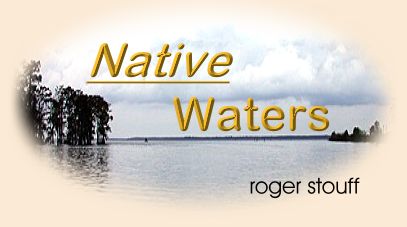|
I sit, sometimes, and look out at the bayou
running behind my house, marking the northern
border of the reservation.
Bayou Teche, my father's people said, was created
many generations ago when a huge snake attacked
the Chitimacha Nation. It was so large its tail
was at Port Barre, La., and its head near Morgan
City at the junction with the Atchafalaya River.
Many warriors tried to destroy it. Many died. It
took a massive effort of all the tribe's strongest
men to slay the great serpent. It's great body lay
there and decomposed, and water sought out the spot
where it had compressed the earth in its death throes,
forming the small channel. My father's people called
it "teche" meaning "snake."
Geologists tell us that Bayou Teche was a former
channel of the Mississippi River, that great
wonder of rivers, which fanned across the Louisiana
coast for millenia, creating the land upon which I
now live. I do not doubt them. The Vermillion and
Atchafalaya Rivers were once channels of the
Mississippi, we are told. I do not doubt this
either.
But I do not doubt that my father's people
fought and killed a giant snake, and some
ages later, the mighty Mississippi flowed
down the course of its grave. The two are
not mutually exclusive.
It is the inability to believe which astounds me
sometimes, as I walk along the water's edge,
watching small bream strike at bugs and chase
minnows. I stand on the dock away from the bayou
bank and watch the current take debris downstream,
and I know an epic struggle took place where I
cast my gaze.
But it is far easier to believe in inanimate forces,
the natural movements of the earth and its waters.
I know that science can be comforting because people
want to be comforted, want to apply order and
definition to the world around them, to their lives.
To believe that a miles-long snake carved out the
channel of Bayou Teche takes away order, introduces
uncertainty, conjures fear and danger.
Did a living, breathing serpent of flesh and
blood attack the Chitimacha nation? In the
collective consciousness of the people it did.
In each village, around the campfires as the
young listened in wide-eyed amazement, it did.
In the generational memory of each passing on
of the story, it did. Descartian reductionism
seeks to lift the veil, reveal the wizard behind
the curtain, and in so doing takes away the wonder
of looking out at Bayou Teche and seeing a
mind's-eye view of heroism, replacing, reducing
it to the haphazard, mindless movement of water.
"There were giants in the earth in those days,"
we are reminded. Perhaps we study the skeletons
of those giants in natural history museums, on
educational channel documentaries of paleontological
digs, and apply order, definintion and Latin names
to them. In so doing, the simple statement, "There
were giants in the earth in those days," loses all
its wonder, grows fat and cumbersome with elaboration.
I want the wonder back. I have a plan to rescue
it. I will one day take the boat from Port Barre
to Morgan City. I will ride the spine of the
great snake from tail to fang, noting where
its vital organs might have fallen, where
Chitimacha warriors might have concentrated
their spears and arrows. I'll cross the Wax
Lake Outlet which now intersects the Teche
and make my way onward, until I reach the
river, and hear the great rasping of its
nostrils, the flick of its tongue.
Some of us refuse to shed the wonder. It doesn't
matter how deeply we reduce it. It doesn't matter,
because we choose to believe in it. We refuse to
let go the wide-eyed gazes around campfires. We
refuse to view this meandering, beautiful waterway
as nothing more than an accident. The great villages
of shell banks, with children playing along the
water's edge, men pulling fish nets and traps,
women making baskets, may be gone, but the memory
of them survives with a giant snake and epic battles.
What can be so wrong with believing in a little
wonder, of giants in the earth, and heroic
struggles of humanity? ~ Roger
|



